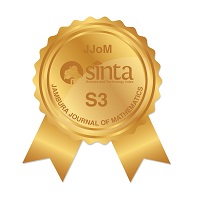Mathematical Model of Coastline Changes in the Ujung Pangkah Gresik Using the Polynomial Lagrange Approach
Abstract
Keywords
Full Text:
PDFReferences
J. Liu, L. Zhou, Y. Tan, Q. Wang, Z. Hu, J. Li, X. Jiang, and Z. Ke, "Distribution of reactive aluminum under the influence of mesoscale eddies in the western South China Sea" Acta Oceanologica Sinica, vol. 36, no. 6, pp. 95-103, jun 2017, doi: 10.1007/s13131-017-1046-7.
H. Phan, A. Reniers, T. Ye, and M. Stive, "Response in the Mekong deltaic coast to its changing sediment sources and sinks" in Proceedings of Coastal Dynamics, 2017, pp. 311-322.
C. Wang, Y. Zhao, X. Zou, X. Xu, and C. Ge, "Recent changing patterns of the Changjiang (Yangtze River) Estuary caused by human activities" Acta Oceanologica Sinica, vol. 36, no. 4, pp. 87-96, apr 2017, doi: 10.1007/s13131-017-1017-z.
U. U. Henry, J. Igbokwe, and A. C. Chukwocha, "Assessment of coastaline vulnerability for sustainable coastal development and planning in Nigeria using medium resolution satellite images and GIS" International Journal of Engineering and Management Sciences, vol. 4, no. 4, pp. 408-416, 2013.
L. O. Dragomir, P. D. E. H. Petrosani, and S. Oncia, "Using satellite images LANDSAT TM for calculating normalized difference indexes for the landscape of Parang Mountains" GeoCAD, 2012.
S. Zeinali, M. Dehghani, M. Rastegar, and M. Mojarrad, "Detecting shoreline changes in Chabahar Bay by processing satellite images" Scientia Iranica, vol. 24, no. 4, pp. 1802-1809, aug 2017, doi: 10.24200/sci.2017.4271.
X. Li and M. C. Damen, "Coastline change detection with satellite remote sensing for environmental management of the Pearl River Estuary, China" Journal of Marine Systems, vol. 82, pp. S54-S61, aug 2010, doi: 10.1016/j.jmarsys.2010.02.005.
A. Paytan, K. R. M. Mackey, Y. Chen, I. D. Lima, S. C. Doney, N. Mahowald, R. Labiosa, and A. F. Post, "Toxicity of atmospheric aerosols on marine phytoplankton" Proceedings of the National Academy of Sciences, vol. 106, no. 12, pp. 4601-4605, mar 2009, doi: 10.1073/pnas.0811486106.
C. Zhong, W. P. Xiao, and B. Huang, "The response of phytoplankton to mesoscale eddies in western South China Sea" Adv. Mar. Sci, vol. 31, no. 2, pp. 213-220, 2013.
T. R. Parsons, Y. Maita, and C. M. Lalli, A Manual of Chemical & Biological Methods for Seawater Analysis. Elsevier, 1984. ISBN 9780080302874 Doi: 10.1016/C2009-0-07774-5.
M. V. Khamutova, V. A. Kushnikov, and O. I. Dranko, "A mathematical model for choosing an action plan for the prevention and elimination of flood effects" IFAC-PapersOnLine, vol. 55, no. 3, pp. 113-118, 2022, doi: 10.1016/j.ifacol.2022.05.020.
J. G. Wallwork, Mesh Adaptation and Adjoint Methods for Finite Element Coastal Ocean Modelling. PhD Thesis: Imperial College London, 2021.
T. Nguyen, J. Peterson, L. Gordon-Brown, and P. Wheeler, "Coastal changes predictive modelling: a fuzzy set approach" World Acad Sci Eng Technol, vol. 48, pp. 468-473, 2008.
C. Chalons and A. Del Grosso, "Exploring different possibilities for second-order well-balanced Lagrange-projection numerical schemes applied to shallow water Exner equations" International Journal for Numerical Methods in Fluids, vol. 94, no. 6, pp. 505-535, jun 2022, doi: 10.1002/fld.5064.
P. Othata and N. Pochai, "Irrigation Water Management Strategies for Salinity Control in the Chao Phraya River Using Sualyev Finite Difference Method with Lagrange Interpolation Technique" Engineering Letters, vol. 29, no. 2, pp. 332-338, 2021.
R. Gens, "Remote sensing of coastlines: detection, extraction and monitoring" International Journal of Remote Sensing, vol. 31, no. 7, pp. 1819-1836, apr 2010, doi: 10.1080/01431160902926673.
R. Bynoe, "Trekking the Shore: Changing Coastlines and the Antiquity of Coastal Settlement" Quaternary Science Reviews, vol. 34, pp. 146-147, feb 2012, doi: 10.1016/j.quascirev.2011.12.016.
H. Wibisana, N. Handajani, and P. C. Wardhani, "The Mathematics Model Analysis of Distribution Concentration of Total Suspended Solid in Gresik Coastal Coast with Landsat 8 Satellite Imagery" Nusantara Science and Technology Proceedings, pp. 288-294, 2021.
H. Wibisana and S. Zainab, "Time Series Analysis of Sea Surface Temperature With Aqua MODIS from 2011 to 2016. Case Studi: North Coast of Gresik and Madura" IPTEK Journal of Science and Technology, vol. 28, no. 1, pp. 15-19, 2017.
P. Soille and M. Pesaresi, "Advances in mathematical morphology applied to geoscience and remote sensing" IEEE Transactions on Geoscience and Remote Sensing, vol. 40, no. 9, pp. 2042-2055, sep 2002, doi: 10.1109/TGRS.2002.804618.
DOI: https://doi.org/10.34312/jjom.v5i1.17077
Copyright (c) 2023 Hendrata Wibisana, Primasari Cahya Wardhani, Novie Handajani

This work is licensed under a Creative Commons Attribution-NonCommercial 4.0 International License.
Jambura Journal of Mathematics has been indexed by
Jambura Journal of Mathematics (e-ISSN: 2656-1344) by Department of Mathematics Universitas Negeri Gorontalo is licensed under a Creative Commons Attribution-NonCommercial 4.0 International License. Powered by Public Knowledge Project OJS.
Editorial Office
Department of Mathematics, Faculty of Mathematics and Natural Science, Universitas Negeri Gorontalo
Jl. Prof. Dr. Ing. B. J. Habibie, Moutong, Tilongkabila, Kabupaten Bone Bolango, Gorontalo, Indonesia
Email: [email protected].




















